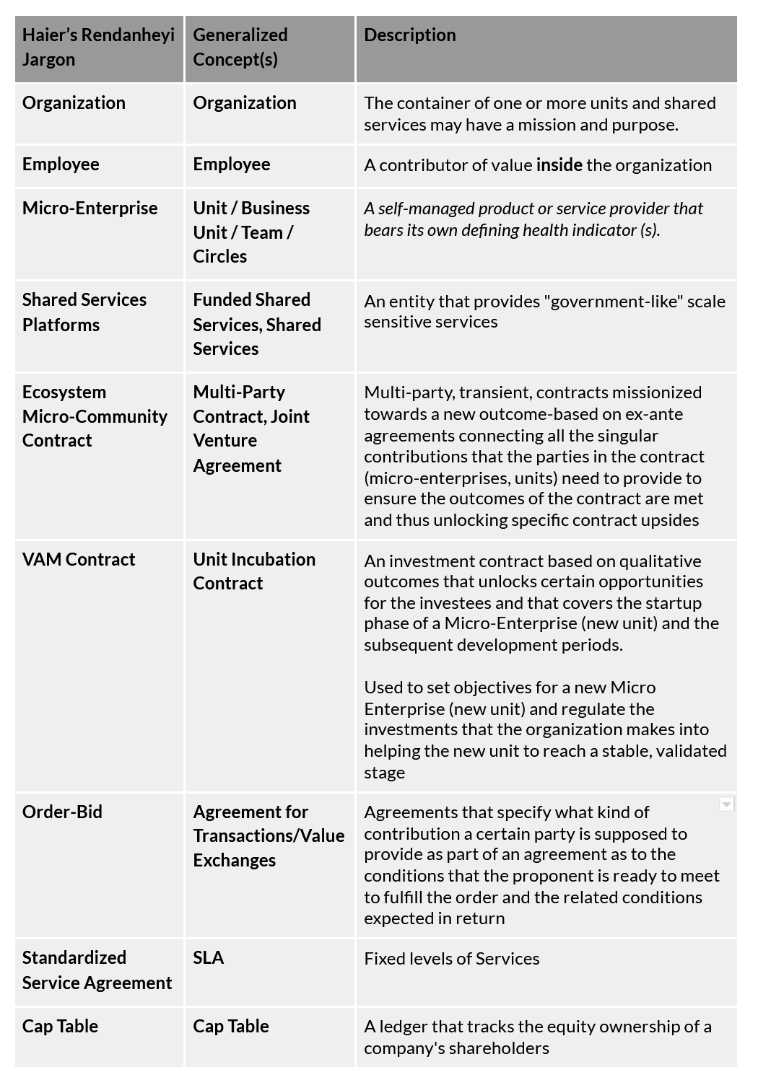the Entrepreneurial Ecosystem Enabling Organization 3EO Model may be a breakthrough in organizational development. _See Exploring Rendanheyi for background._
# First of all, the basics Here’s a list, and a description, of the basic artifacts that we believe constitute this sort of basic set of elements that make up the EEEO/3EO organizations. Most of them will be presented with the name they have in the context of Haier’s Rendanheyi — the most important inspiration so far for the EEEO/3EO framework and arguably the most advanced organizational model in the world when it comes to embracing the thesis presented at the opening of the post: the Micro-Enterprise; the Shared Services Platforms; the Ecosystem Micro-Enterprise Community Contract.
# Other key artifacts The set of artifacts needed to complete the description of a 3EO, unbundled organization, including of course also: an Employee – normally identified by an Identity, a Reputation, and a graph of belonging to one or more Micro-Enterprises; an Organization – defined as the container of one or more MEs and SSPs and defined by its Identity, Reputation but also by its Vision and Purpose (in almost every case). The Organization can be seen as a fractal, with one single organization defined as containing or being contained by a larger organizational container. For example, in Haier, one would find the Organization (Haier Group) controlling directly many subsidiaries that in turn are organized as above, and also many fields and sub-fields that in the case of Haier describe the operations that pertain to a specific area of interest (e.g.: Food, Smart Home…). On top of the artifacts introduced, two more need to be specified. The first is the easiest, and we’re talking about a “black box”. The black box represents an external party, that is defined by its Identity and — potentially — Reputation but doesn’t use the same “organizational grammar” we’ve been describing so far. A black box can still be engaged with a standardized and simple bid-order contract (which is effectively an abstraction of a basic trade contract overall).
# The VAM (Micro-Enterprise incubation) Contract The last one is a very important artifact and it’s called a VAM Contract. VAM – which stands for Value Adjustment Mechanism – is a mix between an investor term sheet, a contract and a corporate budgeting statement. VAM contracts are signed between ME prospect owners (employees) and the organizations (or its fractal divisions). VAM contracts have historically been frequent in Asia and are to be seen as **qualitative term sheets** that are based on the idea of having an **investment contract based on qualitative outcomes** that unlock certain opportunities for the investees (essentially often access to more equity). VAMs normally cover the **constitution phase of a Micro-Enterprise and the subsequent development periods** (yearly reviews) and are used to set objectives for a new Micro-Enterprise and regulate the investments that the organization makes into creating one. **VAM contracts contain 5 key elements:** -basic information of the micro-enterprise such as who are the employee founders/leaders; -detailed information about the ME aim, and leading goals; -a description of how the ME will reach the goals; the needed resources for the ME to pursue its startup, including capital; -the inflection points that will represent the moment the startup process is ended. -information about the upsides for the employees in terms of employee bonuses, accessing profits, and accessing equity.
Clearly, VAM contracts best apply to 3EOs that adopt Positive P&L as the **defining health** function of the Micro-Enterprise and may need tuning to be fully applicable to contexts where other metrics are adopted. The formulation of this mix of **dynamic contracts**, and targets may be emerging as an evolution of the **traditional stable organization structure**.
# A Recap on common artifacts As a recap, here’s the full list of EEEO/3EO artifacts:

Remote image source ![]()